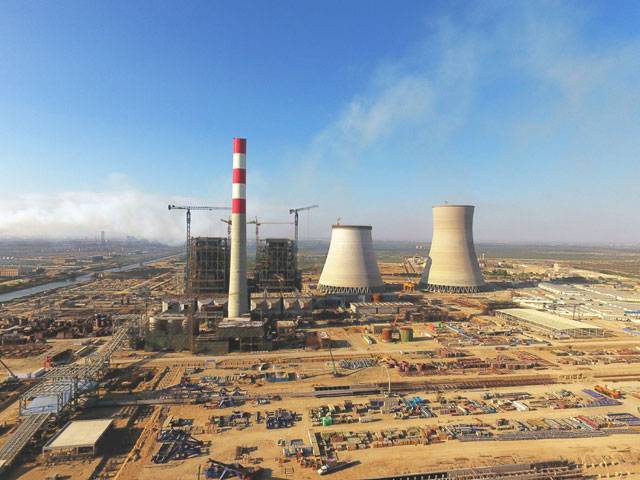Lahore - The construction work on the 1,320MW Port Qasim Coal-Fired Power Project has made a major breakthrough, as 70 percent civil work has already been completed while 73 percent work has been executed over the jetty within one and a half year.
Port Qasim Coal-Fired Power Project ranks first among the Priority Implementation Projects in the energy sector being developed under the CPEC. This is one of the early harvest projects and is expected to achieve commercial operation status by June 2018. The project, however, will start generating power by the end of year 2017.
The project is being jointly developed by Power Construction Corporation of China through Powerchina Resources Limited and Al Mirqab Capital S.P.C. Powerchina and Al Maqrib have holding of 51% and 49% shares respectively on Build-Own-Operate (BOO) basis in the 1320MW power project.
Mr. Cai Bin, CEO of the Company, said that with the start of the month of October, the shell of number-one cooling tower reached top, the generator and turbine started consignment, and the start-up boiler started erection work.
He said that all the works are being completed ahead of the schedule and with good quality, aiming to deliver reliable and affordable electric power to the people of Pakistan as early as possible.
The project comprises two units with total gross capacity of 1320 megawatts (with integrated self-use Jetty) and an average annual energy output of around 9000GWh, able to support 3-4 million families’ power consumption for a year.
Fueled by imported coal, the project adopts the world’s leading supercritical thermal technology - being introduced in Pakistan for the first time.
The environment-friendly operations including seawater desalination, secondary circulating seawater cooling and flue gas desulfurisation, satisfying the environmental standards of the World Bank. The generated power will be evacuated through 500KV AC transmission line connecting the project with the national grid. The construction period of the project is 36 months.The total investment of the project is approximately $2.085 billion. The loan is arranged by the sponsors through project financing from the Import-Export Bank of China (China EXIM Bank), without increasing the financial burden of Government of Pakistan. The construction of the plant started on May 7, 2015. Over 50 per cent of the engineering works were achieved by October, 2016.
Mr. He Shiyou, Deputy General Manager of the company, told that the Complex satisfies the environmental standards of the World Bank.
"We have adopted the world’s leading and mature technology – supercritical thermal technology for this plant which provides high-efficiency, low coal consumption and low emission of carbon dioxide," he said.
He added that though this technology is increasing the project cost but Power China wanted to ensure least impact on the public life.
Shiyou said that the Company had also put in place other environmental friendly operations to make sure that the human and sea life are not impacted by the plant's emissions.
Another colleague, Mr Fazal Rahim, who is the coordinator of public affairs, said that the company had sought No Objection Certificates (NoCs) from Sindh Environmental Protection Agency (SEPA). "SEPA granted approvals of environmental impact assessment of the power plant and jetty respectively on 17 June 2014 and 30 January 2015, after lengthy evaluation procedures including rounds of public hearings attended by local residents, communities, government authorities, factories, NGOs, fisheries' association, research institutes and the media," he added.
Mr. Fazal said all the observations raised by the audience were deliberated upon by the project sponsor and considered in the project design or expressly clarified to relevant stakeholders.
Chinese investor are encouraged by the Chinese government to develop power project in Pakistan, with a target to address the dire energy shortage of brotherly country.
''Currently, thousands of Chinese workers are working at project site enthusiastically, thousands of miles away from their families. We are here to work for the well-being of the Pakistani people. We are confident that our sacrifices would be fully recognized here." says Mr. Wu Xianing, one of the constructors working at the site.
Port Qasim Coal-fired Power Project applied for upfront tariff which is approved by NEPRA after lots of professional experts’ study and public hearings. Mr He Shiyou says the Power Project is not aiming at earning the highest profit by using coal to sacrifice the environment.
"On the contrary, it applies supercritical technology seeking the imported coal from Indonesia or Australia with higher calorific value, to reduce the coal consumption and emission of carbon dioxide," he added.
Mr Zafaryab Khan, the spokesman at Ministry of Water & Power, says that the procedures and machinery installed at Port Qasim Power Project was even better than what being practiced in the modern world. He said the carbon dioxide emissions from Port Qasim Power Plant would be "very low", having no negative impact on human or marine life. He also rubbished the criticism over coal fired power plants and said that even developed countries like Malaysia, Japan and even US were using coal power plants. "In the US, 43 percent energy needs are being met through coal plants. Moreover, Port Qasim Power Plant is adopting the same procedures as adopted in developed nations. They would be using imported high quality coal while supercritical thermal technology is being used by the company which ensures very low emissions," he added.
He said that SEPA had issued NoCs to the company after making sure that there is no environmental cost due to the project. He said that even the ADB-funded power project at Jamshoro had adopted the same technology.
"You know, the ADB and World Bank make sure that there is no impact on environment due to these coal-based power projects. Same is the case with Power China which has adopted all necessary safeguards and best practices to ensure environmental protection," he added.






